
© L. RUDMAN
8 |
Text by Helen M. Barber-James |
|---|---|
Mayflies
Order Ephemeroptera
Mayflies are an ancient group of freshwater insects; their fossils date back some 300 million years. They have a unique maturation stage between aquatic nymph and mature adult (imago) (1) called the subimago (1a), a fully winged, terrestrial stage resembling the adult, but sexually immature. The subimago completes one more moult into the imago (1b). Fly-fishermen refer to the subimago as a ‘dun’ and to the imago as a ‘spinner’. Opaque wings with a covering of small water-resistant hairs characterise the subimagos of most species, as do relatively short unfurled forelegs in males. In contrast, adults have clear wings and males usually have extended forelegs (1, 1b) for grasping females during mating. Males of some species also have striking turbinate eyes (1c). Hindwings, if present, are much smaller than forewings, and often have a spur on the upper margin. Two or three long caudal filaments (tails) (e.g. 1, 1b) are present at the end of the abdomen. Adult mayflies are short-lived, many surviving for only a few hours, just long enough for mating and egg-laying. The length of the life cycle and number of generations per year varies, with tropical species having shorter life cycles and more generations per year than temperate ones.
Nymphs are always aquatic; this is the longest developmental stage. Most nymphs have up to seven pairs of abdominal gills (usually thin and leaf-like), though these may be modified, and they usually have three filaments at the end of the abdomen. The mouthparts are generally adapted for collector-gatherer and deposit feeding or scraping, but a few species are predaceous. The mouthparts are useful for identification, especially the shape of the labial palp. The number and arrangement of denticles (microscopic teeth) on the claws is also diagnostic. A burrowing habit has developed independently in several families.
There are over 3,000 described species in 42 families and >400 genera globally. Approximately 105 species are recorded in southern Africa, with new species still being discovered. Species may be highly sensitive to, or relatively tolerant of, environmental disturbances. This chapter focuses on a few representative members from each family, using simple diagnostic features. Body length measurements given exclude the filaments (tails) at the end of the abdomen.
Small minnow mayflies
Family Baetidae

© L. RUDMAN

© P. KOTZEE

© P. KOTZEE

© P. KOTZEE

© P. KOTZEE
Nymph streamlined with leaf-like gills, downturned mouthparts and antennae longer than twice the width of the head. Adults may have one or two pairs of wings; forewings characterised by simple venation with single or paired marginal intercalary veins (see label, 1d); these are tiny, short, disconnected veins along the lower wing margin, between the long veins. Males have bulbous upwardly extending portions above their eyes (1c) (‘turbinate’ eyes), often orange to red in colour. Body 5–14mm in length. Associated with a variety of water body types, from rapidly flowing streams and waterfalls to still ponds. Nymphs swim with sinuous fish-like movements. Females of some species parthenogenentic (produce fertile eggs without mating), some ovoviviparous (eggs develop within the female, and hatch as they are laid). The dominant African mayfly family, it is represented by 48 species in 22 genera in southern Africa. Southern African genera not described here include Barnumus, Bugilliesia, Centroptiloides, Cloeodes, Crassabwa, Dabulamanzia, Dicentroptilum, Nigrobaetis, Ophelmatostoma, Peuhlella, Procloeon, Pseudocloeon and Securiops.
2 Stickleback baetids
Acanthiops species


© H. BARBER-JAMES
Nymphs (2) have variously developed dorsal abdominal tubercles (spines); nymphs of some species have telescoping abdominal segments. Adults have long asymmetrical gills, with prominent branched veins; upper part of thorax broad and laterally flattened; middle tail undeveloped in all but one species; two rows of tiny teeth visible on the claws at the end of the leg. Each adult forewing with single intercalary vein; hindwings with single hooked spur on top, 2–3 longitudinal veins and no cross-veins. Three species known in southern Africa. Sometimes confused with certain spiny crawlers (Teloganodidae, especially Ephemerellina and Nadinetella) (p.150, 1 and 3). Size: Body up to 7mm in length. Biology: Nymphs found primarily under small to medium-sized stones in fast- and moderately flowing streams. Adults usually fly at sunset.
3 Hanging-gilled baetids
Afrobaetodes species
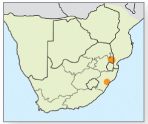

© H. BARBER-JAMES
Nymphs distinguished by ventrally (downward) orientated gills with unbranched veins (3) and presence of a pair of tiny finger-like processes between base of front legs, claws with one row of teeth and abdomen ending in two caudal filaments; small dorsal tubercles usually present on abdomen. In adults, forewings have single intercalaries, hindwings of females narrow, spurless and lacking venation, male hindwings with single well-developed spur and two nearly parallel longitudinal veins. One southern African species known. Size: Small nymphs, body 3mm in length. Biology: Found in tropical regions in currents under small to medium-sized stones or gravel. Adults active during the day.
1 African sulphur duns
Afroptilum species


© H. BARBER-JAMES
Nymphs with a somewhat flattened abdomen, often without distinctive markings. Gills (1) laterally (sideways) orientated, A. sudafricanum with only six pairs. Middle caudal filament well developed, but shorter than lateral filaments. Two rows of teeth on claws. Labial palps of mouthparts end in a characteristically tiny palp. Adults have forewing with single intercalaries. Hindwing present only in male, with two or three longitudinal veins and a two-forked spur. Turbinate eyes are pale cream basally, reddish brown dorsally. Two species known in southern Africa. Size: Body up to 8.5mm in length. Biology: Widespread. Nymphs found under small to medium-sized stones in variable current conditions. Nymphs climb up rocks and out of the water before the subimago emerges. Adults fly in autumn, spring and summer.
2 African blue-winged olives
Baetis species
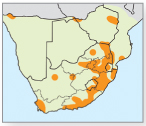

© C. GRIFFITHS

© C. GRIFFITHS
Nymphs (2) fusiform (tapering at both ends); abdomen often with pale oval pattern on each side of midline; claws with teeth in a single row and labial palp segment 3 broadly rounded. The middle caudal filament usually shorter than lateral filaments, often with dark band in the middle. Mature male nymphs have enlarged eyes. Male imago has orange-red turbinate eyes. Forewing with double intercalaries, hindwing with single spur (2a) and 2–3 longitudinal veins. Image (2a) shows female ovipositing on a rock. Four nominal species in South Africa, but one of these, B. harrisoni, is known to be a species complex. Size: Body 8–9mm in length, varies according to season. Biology: Widespread. Nymphs found in riffle areas under small to medium-sized stones in rivers and are present throughout the year.
3 Long-clawed sand creepers
Cheleocloeon species


© H. BARBER-JAMES
Nymphs (3) with labial palp segment 2 having a pointed thumb-like extension. Claws elongated, with either two rows of tiny teeth or no teeth. Medial caudal filament well developed. Forewing with single marginal intercalaries; hindwing absent in female, but in male with single strongly inward-curved spur (making a C-shape) and two longitudinal veins. Two species known in southern Africa. Size: Body 7mm in length. Biology: Nymphs found in slow riffles and stony or sandy backwaters, often associated with water plants; nymphs rise to the water surface for emergence.
4 Double-gilled pond creepers
Cloeon species


© C. GRIFFITHS
Nymphs (4) usually have rounded double gills on segments 2–6 or 1–5 (depending on species). Claws relatively long, with tiny teeth in the basal third. In both sexes hindwings absent and forewings have single marginal intercalaries. Adults with two caudal filaments.Ten species known in southern Africa. Size: Body 3–7.5mm in length. Biology: Nymphs found in pools, backwaters or temporary water bodies, often among vegetation. Adults emerge in open water, away from the shore; eggs are laid on the water surface at dusk. Some species ovoviviparous. Females retreat to a secluded place until eggs are ready to hatch.
5 Two-tailed waterfall baetids
Demoreptus species


© C. GRIFFITHS
An endemic southern African genus. Nymphs (5) have an undeveloped medial caudal filament, and relatively narrow elongate body; labial palp segment 3 club-like; legs outstretched. In adults forewings have paired marginal intercalary veins; hindwings present except in males of D. natalensis. Three species known. Size: Body 6–7mm in length. Biology: Nymphs found in fast-flowing mountain streams, often associated with waterfalls.
6 Dainty sand dancers
Demoulinia species


© H. BARBER-JAMES
Nymphs (6) easily recognised by long slender tarsal claws, with fine teeth near base. Labial palp segment 2 has a prominent inward bulge, segment 3 is small. Well-developed medial caudal filament. Gills distinctively shaped like a paint palette, with dark veins. In adults, forewings have single intercalary veins, hindwings absent in both sexes. One species in southern Africa. Size: Body up to 8mm in length. Biology: Nymphs sand-dwelling, generally found in lowland streams in deep sections of water.
7 False pannote baetids
Pseudopannota species


© H. BARBER-JAMES
Nymphs (7) may have pale stripe along body; they have labial palps with two segments, and segment 2 is apically expanded or bulbous; forewing pads generally fused for more than half their length. Medial caudal filament well developed. One species (P. maculosa) known in southern Africa. Adults unknown. Size: Body 5.5mm in length. Biology: Nymphs found under stones and among vegetation in moderately flowing streams at high and low elevations.
Brushlegged or helmet-head mayflies
Family Oligoneuriidae

© H. BARBER-JAMES

© Y. JANSSEN
Nymphs have long hairs on inner margins of the forelegs, used for filter-feeding; gills double – gill 1 ventrally orientated, usually with a tiny upper lamella over a larger frilly gill, remaining gills laterally orientated, consisting of larger upper lamella over a smaller, branched, frilly gill; base of maxillae has tufted accessory gills (see label) (1). Three caudal filaments, each shorter than abdomen. Adults with large wings (1a); forewings isosceles triangle-shaped, with four or five characteristic twinned convex veins, hindwings also with paired veins. Large, some >20mm. Nymphs occur in fast-flowing water. Adults are strong fliers. Represented by two genera in southern Africa, Elassoneuria not discussed in detail.
2 Mountain helmet-heads
Oligoneuriopsis species


© H. BARBER-JAMES
Nymphs (2) distinguished from Elassoneuria by absence of a frontal crest on head; head apically rounded. Gills 2–7 each have a lamella shorter than the segment from which it arises. Adult forewings with five strong convex veins; male genital claspers have four segments. Median caudal filament shorter and weaker than lateral ones. Three species in southern Africa, occurring in Lesotho, KwaZulu-Natal and Eastern Cape (also in Kenya and North Africa). Size: Body up to 19mm in length. Biology: Nymphs found under stones in fast-flowing mountain streams at altitudes of between 1,200 and 1,800m. Adults emerge in autumn, flying at midday.
Flat-headed mayflies
Family Heptageniidae
Nymphs dorsoventrally flattened, with horizontally orientated semicircular head capsule. Legs sprawling; gills 1–6 dorsally lamellate with a frilly ventral tuft, gill 7 lamellate, without a tuft. Nymphs found primarily in riffle areas beneath stones, under a variety of flow conditions and altitudes. Adults have two pairs of wings: forewings narrow and elliptical with many cross-veins, hindwings with small spur. Nymphs cling to rocks in fast-flowing water, scuttling across rocks when threatened. Subimagos emerge from the shallower water at stream margins. Represented by two genera in southern Africa; Notonurus not discussed in detail.
3 Gondwanan flatheads
Afronurus species


© C. GRIFFITHS

© H. BARBER-JAMES
Nymphs (3) have apically rounded or weakly pointed gills (distinguished from Notonurus, which have gills with strongly pointed apices and well-developed pointed plates at the base of the forelegs). Subimagos often have opaque wings with dark brown and yellowish tinge. Imagos (3a) have clear wings. In male, a characteristic darker stripe may circle lower region of eye. Six species known in southern Africa. Widespread in the Afrotropics. Size: 8–13mm in length. Biology: Nymphs commonly cling to rocks in swift water; sometimes found in deeper quieter reaches. Adults emerge at night, throughout summer, peaking in midsummer.
Prong-gill mayflies
Family Leptophlebiidae
Nymphs easily distinguished by their gills; gill 1 absent, or may be a single lamella, operculate or apically cleft; gills 2–6 or 7 are double, and may be lanceolate (spear-shaped) or have pointed projections or multiple finger-like projections. Three long, widely spaced caudal filaments of equal length are present. Adults have two pairs of wings with many cross-veins; male eyes turbinate. Larger species may reach 15mm in length. Nymphs generally occur in flowing waters, but some species prefer backwaters and lotic conditions, usually associated with boulders, stones, gravel, woody debris or roots along stream banks. Adults emerge by climbing out of water onto protruding rocks or plants. Widespread globally. Represented by 13 genera in sub-Saharan Africa, with seven genera and 20 described species in South Africa. Choroterpes and Hyalophlebia not discussed.
4 September browns
Adenophlebia species


© H. BARBER-JAMES

© H. BARBER-JAMES
Nymphs (4) with well-tracheated, double, ovoid gills on segments 1–7, each with single, narrow, tapering point. Teeth on claws increase in size towards tips, with one enlarged tooth near tip. Wings (4a) may have blotchy brown spotting along veins, giving a thickened appearance; hindwing with angular spur. Four southern African species. Size: Body up to 13mm in length. Biology: Nymphs usually occur on stones and can tolerate a range of flow conditions, from still pools to faster-flowing water. Emergence takes place during the day, flying in early spring.
5 Operculate-gilled leptophlebiids
Adenophlebiodes species
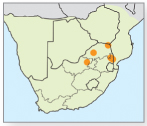

© H. BARBER-JAMES

© H. BARBER-JAMES
Nymphs (5) have large, ovoid, operculate gills on abdominal segment 1; remaining five gills with double lamellae, deeply notched at tip for about a third of the gill length. In A. bicolor (5a), the hindwing and the basal half of the forewing are characteristically suffused with brown pigment. Projection on leading edge of hindwing is rounded and well developed. Size: Body 11mm in length, males smaller than females. Two southern African species. Biology: Tropical. Nymphs found in bedrock-dominated mountain streams, mostly in pools, often associated with vegetation.
1 Smooth-clawed prong-gills
Aprionyx species
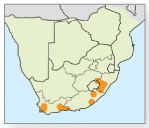

© G. MCKILLERON

© C. GRIFFITHS
Nymphs (1) have gills on segments 1–7, with paired lamellae packed with tracheae and ending in a single filament in most species (three gill filaments in A. tricuspidatus). Claws lack teeth. Tiny double spines present at each bottom corner of abdominal segments 8 and 9. Hindwing with smoothly rounded spur; in some species (1a) veins may be suffused with brown. Endemic to southern Africa; six species from the southwestern Cape, two ranging across mountainous parts of Eastern Cape and KwaZulu-Natal. Size: Body 9–13mm in length, females larger than males. Biology: Nymphs occur under large stones in moderately flowing water and in pools in mountain streams, often associated with patches of natural forest. Nymphs climb up rocks to emerge as subimagos just above the water surface. Adults fly from spring to autumn, some around midday, others at dusk; males swarm, aligning themselves with markers along the banks.
2 Chestnut duns
Castanophlebia species


© C. GRIFFITHS
Nymphs (2) have long, slender, tapering double gills on abdominal segments 1–7, with a single, unbranched, main trachea. Claws, with largest tooth in the middle. Forewings long and narrow, without markings, hindwings about a fifth of the length of the forewings, spur takes the form of a shallow convexity, more-or-less in the middle of the upper wing margin. Occurs in mountain streams in Lesotho and South Africa. Only two species currently known. Size: Body up to 9mm in length. Biology: Nymphs prefer fast-flowing waters; usually found under stones and have been observed on the rock faces of small waterfalls, often associated with forest. Adults emerge during the day in spring and early summer.
3 Common prong-gills
Euthraulus species


© H. BARBER-JAMES

© H. BARBER-JAMES
Nymphs a nondescript dark brown colour, with gill 1 a single long filament and gills 2–7 (3, 3a) double, with three slender filaments at their tips. Claws with small teeth growing progressively larger towards apex. In adults, spur of hindwing is covered with small scales. Widespread in Africa, with only one species (E. elegans) currently described in South Africa but others recognised. Size: Body 7–8mm in length. Biology: Nymphs prefer slow-flowing waters. Adults fly in summer, emerging from the water surface at night.
Smoke-winged (pale) burrowers
Family Polymitarcyidae
Burrowing mayflies all have mandibular tusks and feather-like gills. Polymitarcyid nymphs have apically convergent tusks and a small rounded frontal process on the head. Gill 1 small, single or double; gills 2–7 double, consisting of long feathery lamellae, dorsally orientated. Adult males have two caudal filaments, females have two or three. Forewings with many cross-veins, giving the wings a net-like appearance, fore- and hindwings opaque; hindwings large, approximately a third of the size of the forewings, also with net-like venation. Legs atrophied except for forelegs of male. Body up to 19mm long. Nymphs burrow into hard substrates such as fallen logs in a river, or between particles in mixed substrate, usually in slow-flowing waters. They feed by fanning their gills to create a current through their burrow, as is typical of burrowing mayflies. Members of this family prone to mass emergences, forming mating swarms; dying females then expel eggs on the water surface. Two southern African genera. The family Euthyplociidae (e.g. Afroplocia sampsoni) is sometimes included in the Polymitarcyidae – these are rarely encountered and not discussed further here.
4 Rough-tusked burrowers
Ephoron species
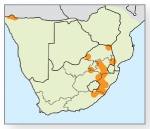

© C. GRIFFITHS
Widely distributed in Africa, currently represented by one described species (E. savignyi), an under-representation of the true diversity, as more undescribed species are likely to exist. Nymphs have robust mandibular tusks bearing numerous tubercles laterally and dorsally. Wings with dense net-like venation. Two long caudal filaments in male, three shorter ones in female. Size: Body 16mm in length. Biology: Nymphs burrow interstitially in mixed substrate, also associated with detritus and roots, in relatively shallow water. Adults fly at dusk. Females mate as subimagos.
5 Big-tusked wood burrower
Povilla adusta


© C. GRIFFITHS
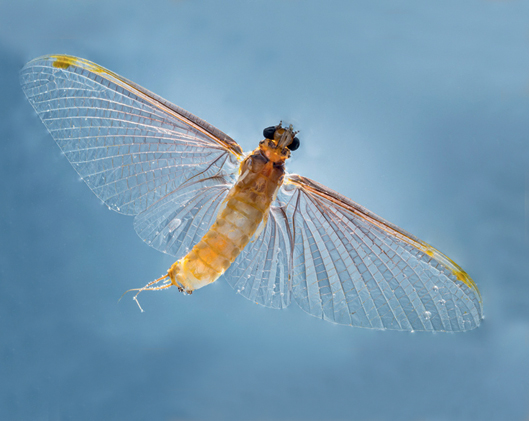
© P. NASKRECKI
African Povilla are known from one species. Nymphs (5) have short robust mandibular tusks, with strong teeth along the inside margin and three caudal filaments shorter than the body. Gill 1 small, bifid, gills 2–7 double, feathery. In adult (5a) hindwing has acute costal projection. Middle and hindlegs of male and all legs in female (5a) atrophied. Size: Male imago up to 13mm in length, female up to 20mm. Biology: Found in lentic waters; burrows into clay, sandstone, woody substrates and freshwater sponges; burrows lined with a papery substance. Emergence associated with lunar rhythms.
Common burrowers
Family Ephemeridae
Nymphs with apically divergent mandibular tusks, variously developed frontal process, depending on genus, and an extension of the tibiae of the posterior legs. Gill 1 small, bifid, ventrally orientated; gills 2–7 dorsally orientated, consisting of double elongate lamellae with fringed margins. Adults with clear wings, characterised by the presence of numerous small veinlets in the anal region. Body up to 30mm in length. Nymphs are found primarily in lentic waters, burrowing in clay or silt. Three genera: Ephemera (discussed below) Afromera and Eatonica (not discussed).
1 Mooi River burrower
Ephemera mooiana


© H. BARBER-JAMES
Nymph with well-developed concave frontal process, fringed with pale setae, and well-developed tusk-like mandibles (1). Adult male’s legs all functional; female unknown. One species known in Africa, found only in the Mooi River in KwaZulu-Natal and considered recently extinct, as it has not been collected for nearly 70 years (image shows preserved specimen). Size: Mature nymph up to 25mm in length; male imago 22mm. Biology: Nymphs burrow in mud banks in slow-flowing streams, and live for two years. Subimagos hatch during the day and emerge as adults at dusk, when the mating flight occurs.
2 Pop-eyed mayflies
Family Machadorythidae


© H. BARBER-JAMES
Currently represented by one genus and species only, the Pop-eyed mayfly (Machadorythus maculatus). Nymphs’ eyes on short dorsally oriented stalks; terga 3–7 forming an open V-shaped compartment that protects the gills (2). Adults with hindwings absent; forewings lack marginal intercalary veins; eyes in males meet along midline of head. Only one species known. Size: Body 7mm in length. Biology: Widely distributed in tropical Africa, never abundant. Nymphs found in sand, silt and organic detritus in slow-flowing stretches of streams, apparently predatory. Adult behaviour unknown.
3 Fringed-sucker clingers
Family Dicercomyzidae
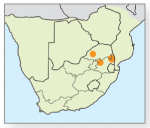

© H. BARBER-JAMES
Currently represented by one genus with four species. Nymphs (3) of Dicercomyzon species have a distinctive dorsoventrally flattened body, enlarged and flattened femora, a circular ventral fringe of setae and fringed gills on segments 2–6. Mouthparts highly modified, with palps reduced. Adult males have large bulbous eyes, foreleg shorter than hindleg and reduced median caudal filament. Upper marginal area in forewings suffused with brown pigment, hindwings absent. Widespread in tropical Africa. Size: Body 4.5mm in length. Biology: Nymphs found in shallow forested mountain streams, often among plant litter trapped by rocks. Adults fly after dusk.
4 Stout crawlers
Family Tricorythidae


© C. GRIFFITHS

© F. DE MOOR
Although only one genus, Tricorythus, is named in Africa, two other undescribed genera are present. The most distinctive feature seen in nymphs of all members of the family are the robust mandibles, with their well-developed brush of setae, clearly seen when observing the nymph from above. Adults lack hindwings, venation of forewings simple. In Tricorythus, eyes of male and female are of equal size, but in most of the South African representatives males have larger eyes than females. Tricorythus nymphs (4) have stout femora, with short flat setae and claws with a few strong teeth. Adult male forelegs of similar length to mid- and hindlegs. Currently four southern African species are named under Tricorythus, but this needs to be revised (4a). Size: Males smaller (body 6–7mm in length) than females (body 9–10mm in length). Biology: Nymphs cling to stones in swift-flowing currents. Subimagos emerge at dusk, resting on rocks to emerge as adults, which happens within an hour. Adults fly from spring to autumn.
5 African oval-gills
Family Ephemerythidae


© H. BARBER-JAMES
Currently represented by one genus, Ephemerythus, with four species. Nymphs with gill 1 absent, gill 2 narrow, oblong, semi-operculate (for partial protection of successive gills), gills 3–5 consisting of oval lamellae covering paired filaments, gill 6, if present, has a small, single, oval lamella (5). Claws with large, widely spaced teeth at base and smaller, more closely spaced teeth near tip. Femora with prominent stubby setae. Adult male’s eyes touch. In both sexes forewings have double marginal intercalaries, hindwings small, narrow, with sharply tapering apices. Three caudal filaments. Size: Body 5–6mm in length. Biology: Tropical distribution, found in both cool mountain streams and warmer lowland rivers. Adults emerge in small numbers at dusk throughout the year, undergoing their final moult during the night, and are active in the early hours of the morning.
Spiny crawlers
Family Teloganodidae
Nymphs have gill 1 present or absent, gill 2 operculate or semi-operculate (for partial protection of successive gills) and maxillary palps absent. They swim with a characteristic dorsoventral flexing of the body. In adults, forewings all have single marginal intercalaries and hindwings are small. Male has divided eyes. Considered a cold-adapted temperate Gondwanan relict family, confined to rivers in the southern and Western Cape regions of Africa, with disjunct records from Madagascar and parts of Asia. Four South African genera, but Lithogloea not discussed here.
1 Spiny-backed crawlers
Ephemerellina species
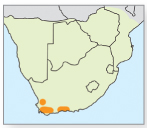

© L. PEREIRA DA CONCEICOA
Gill 1 absent; lamellate gills present on abdominal segments 2–6, gill 2 semi-operculate, with part of following gill pair exposed. Dorsal abdominal tubercles single and sharp (1). Claws have one row of denticles. Adults with gill socket vestiges visible on abdominal segments 2–6. Three caudal filaments. One species described, at least two others distinguishable. Size: Body 8–12mm in length. Biology: Nymphs found in moss on rock faces of waterfalls and on leaves of Isolepis (Cyperaceae) (p.282, 7) in swift-flowing acidic mountain streams. Adults fly at night, November–January.
2 Fringe-faced crawlers
Lestagella species


© G. MCKILLERON

© L. PEREIRA DA CONCEICOA
Gill 1 filamentous; lamellate gills present on abdominal segments 2–4, gill 2 fully operculate. Abdomen lacks tubercles (2). Claws with one row of denticles. Head has well-developed fringe of setae along anterior margin (2a). Adults have three caudal filaments, with gill socket vestiges present on abdominal segments 2–4. Forewing has finely pigmented costal region, hindwing has small spur about halfway along the upper margin. At least three species present, one currently described. Size: Body up to 7mm in length. Biology: Found on large rocks, often with pale green film of algae, in slow to swift currents. Adults fly October–March, from dusk into the night.
3 Nadine’s crawlers
Nadinetella species

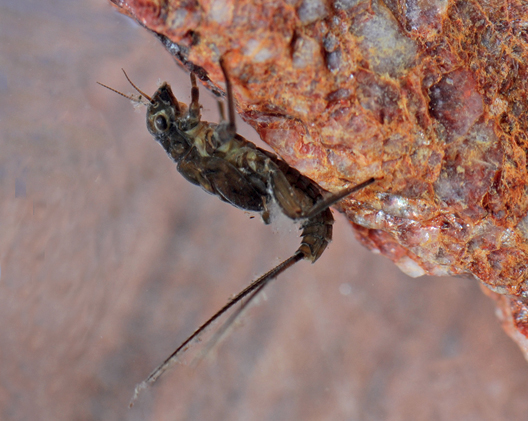
© F. DE MOOR

© F. DE MOOR
Nymph (3) may or may not have filamentous gill 1; lamellate gills present on abdominal segments 2–5, gill 2 semi-operculate (for partial protection of successive gills). Dorsal abdominal tubercles paired, or terga (plates on top of body) with broad straight margins, or at least some terga with slightly branched protuberances near their end. Claws with two rows of denticles. Adults (3a) have gill socket vestiges on abdominal segments 2–5, and small tubercle vestiges dorsally on segments 3–5. Two species currently known. Size: Body 10mm in length. Biology: Nymphs found in Wardia moss (p.310, 4), which grows on rock faces of waterfalls and in swift currents in mountain streams
4 Small square-gills (Caenflies)
Family Caenidae


© G. MCKILLERON
Gill 1 always present and filamentous; gill 2 square and operculate, usually with prominent Y-shaped ridges that form a crest on dorsal surface, touch towards the middle and cover the remaining gills, which are frilly lamellae. Adults lack hindwings; forewings have simple venation. Small nymphs, body length 3–10mm. Nymphs usually associated with little or no flow in pools or ponds, or found among silty substrates in backwaters or among aquatic vegetation, where they feed on fine particulate detritus and periphyton. Body often covered with small detrital particles. Adults tend to fly at dawn. Six genera known in Africa, three recorded from South Africa. Caenis is most common – Barnardara and Clypeocaenis not discussed, but nymphs recognised by having hairy legs. Common square-gills (Caenis species) have forelegs without prominent brushes of long hair-like setae, although whorls of shorter setae may be present; claws usually tapering, teeth very small; outer margin of operculate gills fringed with long hair-like setae (4). Many of the 39 African species are known only as adults. Six species described from South Africa. Size: Body 5–9mm in length. Biology: Nymphs found in still or slowly flowing water. Adults usually fly at dawn; the subimaginal skin is retained on the wings on moulting.
5 Water specs
Family Prosopistomatidae


© H. BARBER-JAMES
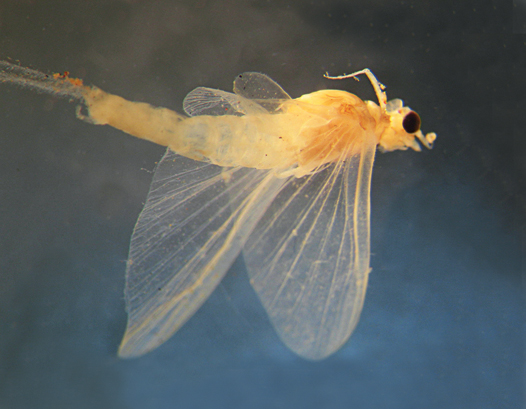
© H. BARBER-JAMES
Currently represented by one genus, Prosopistoma. Nymphs have oval carapace covering the thorax and gills (5). Adults have two pairs of wings (5a). Wing venation unique, with no cross-veins in either fore- or hindwings. Considerable sexual dimorphism (differences in appearance) in wing venation and shape; males’ forewings have long intercalaries adjacent to the main veins, while females’ forewings lack intercalaries. Four species described from South Africa. Size: Body up to 5mm in length, nymphs with short, retractile caudal filaments of <1mm. Biology: Nymphs found under stones in flowing current. Adults emerge at dawn. Females mate as subimagos, and have atrophied legs. They emerge shortly after the males, mate and die within an hour. Eggs are released as the female floats on the water surface after mating.